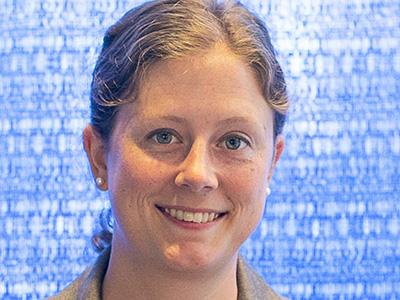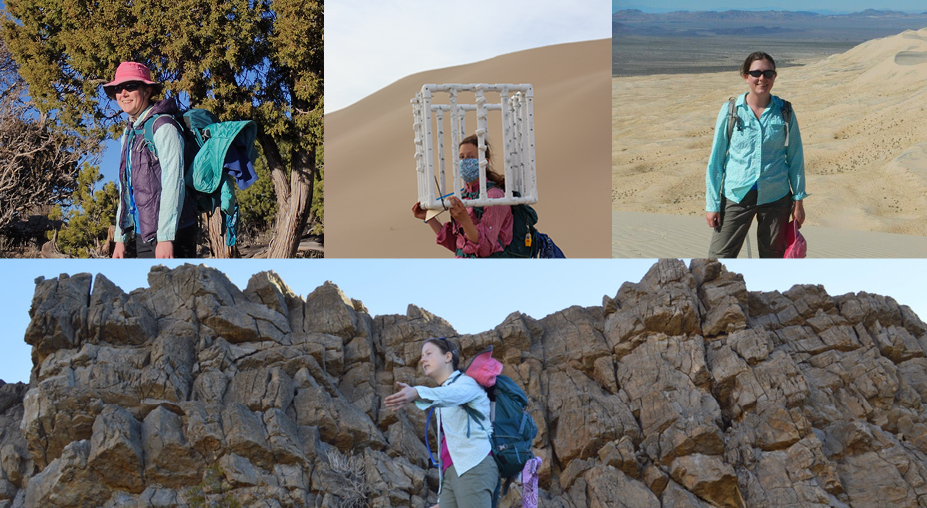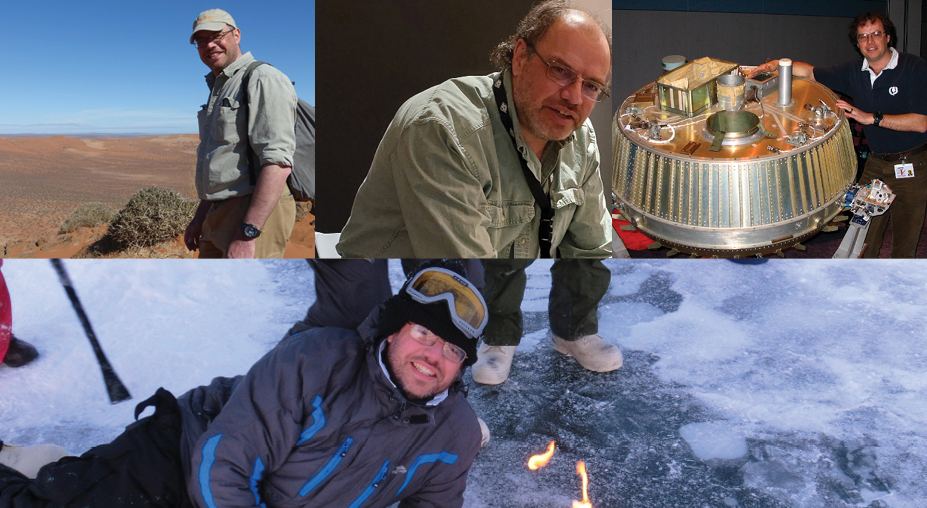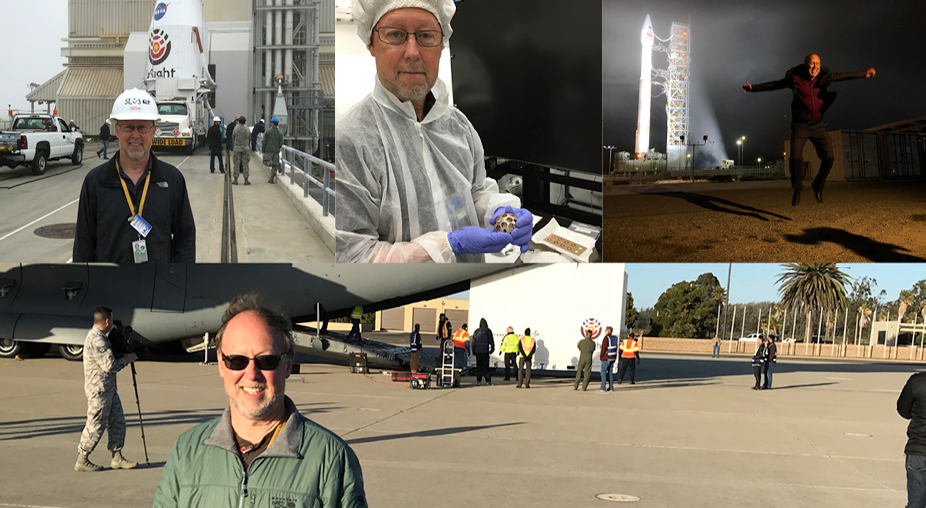Planetary Sciences Section

Citation
Mackenzie Day received her B.S. from the California Institute of Technology in 2012 and her Ph.D. from the University of Texas at Austin in 2017. Mackenzie is now an assistant professor at the University of California, Los Angeles, and she is a leader at interpreting modern and ancient planetary surface systems affected by windblown sediment. Her scientific advances are built on a deep understanding of aeolian processes that is creatively applied to estimate environmental properties encoded in landforms and sedimentary deposits.
Mackenzie’s careful work has demonstrated that the structure of simple dune fields and their constituent dunes are truly reflections of their formative wind regimes and sediment supplies. This has provided foundational support for Earth analogue studies and confirmed that surface conditions on planetary bodies can be accurately estimated using appropriate morphodynamic frameworks. Focusing on craters as a primary source and sink for dune sediment, her research group defined the critical crater wall slope connected to whether sediment eroded from intracrater deposits can be transported out of a crater basin and thereby be transferred to the regional sediment budget. Mackenzie’s expertise in modern aeolian systems has also benefited mission operations, including how different types of windblown deposits affect rover trafficability and identification of sites of active bedrock erosion that likely make optimal sampling locations for ancient Martian biosignatures.
Mackenzie has also made significant contributions to our understanding of the early Martian environment via innovative stratigraphic analyses. These studies have helped define ancient wind fields and properties of the wet-to-dry Mars transition preserved in fluviolacustrine to aeolian sedimentary successions. Evaluating limitations in the spatial resolution of Mars imaging has allowed Mackenzie to demonstrate that many layered deposits are likely aeolianites.
Working across scales, Mackenzie has contributed to a better definition of subthreshold grain saltation at particle dimensions, and a better definition of erosive, rim-generated vortices at the crater scale. Sediment transported by these vortices is commonly worked into dunes that interact with each other as they migrate and grow. Mackenzie has made fundamental contributions to understanding these dune interactions, as well as the sedimentary structures they generate.
Following Ronald Greeley, Mackenzie’s considerable scientific contributions are matched by her professional services that include the training and mentoring of junior planetary scientists. Mackenzie Day has earned the Ronald Greeley Early Career Award for “innovative application of theory, field and remotely sensed data to the erosion and deposition of planetary landforms by windblown sediment.”
—David Mohrig, University of Texas at Austin
Response
I feel truly honored to receive the Ronald Greeley Early Career Award in Planetary Sciences. I never had the privilege of meeting Ron Greeley during his lifetime, but I have certainly learned from him through his work. His contributions to aeolian geology in particular have been at the foundation of much of my research, and I hope my career will reflect his legacy of research and mentorship.
I want to thank the many people who have mentored and supported me over the years, from John Grotzinger, who gave me my first research job as an undergraduate, to David Catling, who gave me the flexibility to explore new ideas as a postdoc. I am grateful for the community of mentors and colleagues I had during my time in Texas, including David Mohrig, Ryan Ewing, and Tim Goudge, and for the wonderful colleagues who welcomed me to my new department at University of California, Los Angeles. I am especially grateful for the support of my graduate adviser, Gary Kocurek, whose patient mentorship and guidance taught me not only how to see the puzzle in the landscape but also how to solve it.
I also want to thank my students and collaborators. Their effort has contributed immensely to my career and cannot be understated. I have been incredibly fortunate to be supported and welcomed by so many people, and I hope to honor that support and Ron Greeley’s legacy by paying it forward as a supportive mentor myself.
—Mackenzie Day, University of California, Los Angeles
Field Photos

Citation
Dr. Ralph Lorenz’s broad scientific and engineering experience has enabled him to make numerous noteworthy contributions to the scientific understanding of several different planetary bodies. His scientific focus is planetary surface-atmosphere interactions, and his fieldwork in the desert regions of Earth has informed and enabled his analysis of aeolian processes on other bodies in the solar system. He has conducted scientific analyses that have enriched our understanding of dust devils on Mars and dunes on Titan, and contributed to such exotic discoveries as lightning on Venus. Furthermore, Ralph has been involved in the life cycle of flight investigations including concept formulation, mission and system design, science planning, observation design, instrument development, data analysis, and publication of results.
Much of the uniqueness of Ralph’s work flows from the innovative sensor platforms used in his scientific investigations and analyses, including probes, landers, balloons, penetrators, drones, and boats. He was a Cassini Radar team member and coinvestigator on the Huygens probe’s Surface Science Package. He is a science team member of the InSIGHT mission to understand Mars’s interior and is the Dragonfly Mission Architect. In addition, he is a science team member and the Payload Experiment Lead for the Venus Atmosphere Structure Investigation on the DAVINCI mission to Venus.
Ralph is a prolific writer, sharing his knowledge with technical and nontechnical audiences. He has first authored almost 200 peer-reviewed publications and has coauthored numerous others. He has also penned many books, including books about planetary climate research (Exploring Planetary Climate: A History of Scientific Discovery on Earth, Mars, Venus and Titan), aerodynamics (Spinning Flight: Dynamics of Frisbees, Boomerangs, Samaras, and Skipping Stones), multiple books about Titan (e.g., Lifting Titan’s Veil: Exploring the Giant Moon of Saturn) and spacecraft (e.g., Cassini-Huygens Owners’ Workshop Manual), as well as coauthoring a book on aeolian processes on planetary bodies (Dune Worlds: How Windblown Sand Shapes Planetary Landscapes).
Ralph truly has an unparalleled breadth of knowledge and impact on planetary science. His overall excellence exemplifies the essence of the Fred Whipple Award.
—Debra Buczkowski, Johns Hopkins University Applied Physics Laboratory, Laurel, Md.
Response
I am deeply honored by the recognition expressed in the Whipple Award, and a little surprised, as I feel that all I have really done is work on what seem like fun and interesting problems. As some may know, I am not reticent to express critique of scientific ideas, and am not always gentle in doing so, so I particularly appreciate my colleagues who have nevertheless persisted in putting together nomination materials.
Although I don’t believe I had close personal interaction with Fred Whipple, one of the moments that set me (at age 16) on a course to work in this field was the apparition of comet Halley in 1986, during which the European Giotto spacecraft made a daring close encounter, protected from dust impacts by a Whipple shield. This theme, of spacecraft and instruments interacting with planetary environments, is perhaps what has defined my career.
I was lucky indeed to start that career on the epic Cassini-Huygens project right at its beginning in 1990, and I have had the great fortune to have worked on various international spacecraft projects since then, as well as in field, laboratory, and theoretical investigations. The range of disciplines and techniques in the planetary sciences is what makes it such an intellectually stimulating enterprise. But what makes it fun, of course, are the people, the many brilliant colleagues, too many to list here (and including several previous Whipple awardees), with whom I’ve puzzled over new images and data, or toiled in the crucible of mission proposals, or changed tires on desert field trips. It is a joy to work with you all!
—Ralph D. Lorenz, Johns Hopkins University Applied Physics Laboratory, Laurel, Md.
Field Photos



